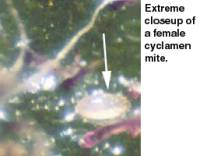


Also known as Tarsonemid Mites
Description
Cyclamen Mites are tiny arachnids and, as such, have eight legs. They may be white, yellow or brown in color. Because they measure only 1/100 inch, you will probably need a magnifying glass to see them. Cyclamen Mites thrive on almost all parts of African Violets, including leaves, stems and flowers. At the same time, Cyclamen Mites tend to avoid light by seeking a safe feeding environment in the crown and leaf folds. For this reason, a ruffled leaf variety may exhibit more widespread damage than other Violets. The damage caused by Cyclamen Mites is compounded by the fact that some mites are carriers of Botrytis. Cyclamen Mites are considered to be the most dangerous among those mites which attack African Violets. If left untreated, they will cause severe damage to your African Violets, eventually destroying it.
Distinguishing Symptoms
If your African Violet exhibits these first two symptoms, there is a strong possibility that it has Cyclamen Mites. However, do not let yourself get caught up in making a definitive identification. It will be enough to know that your Violet has mites, whether or not they are, in fact, Cyclamen Mites. The treatment for all mites is the same. (See below.)
Other Symptoms
Treatment
First, isolate all infested plants. This is important, since Cyclamen Mites move quickly from plant to plant.
Next, treat with Dicofol (as directed on the label). You will need to spray three times, once every fourth day after the initial treatment. Be sure to that the spray reaches the crown and along the folds of any quilted or scalloped leaves. These are the areas where Cyclamen Mites tend to concentrate.
As an alternative to traditional chemical treatments, you may want to try spraying with Neem (Azadirachtin). Neem is a substance which has natural insecticidal properties, and according to currently available research, it is biodegradable and non-toxic. When sprayed on African Violets, it discourages Cyclamen Mites by making the plant unpalatable. Though Neem does have some systemic effect in plants, spray it as you would other contact insecticides, being sure to cover the crown where Cyclamen Mites tend to cluster.
Prevention
Always isolate new plants until you can positively determine that they are not infested.
Thoroughly wash hands before handling your plants.
Before repotting, pasteurize soil and disinfect pots with a 10 percent bleach solution, i.e., 1 part bleach to 9 parts water.
Important Note on the Use of Pesticides
Please note that almost all pesticides are formulated for specific uses and conditions. When applied incorrectly, pesticides can cause ill health or damage to plants. Therefore, when using any kind of pesticide or chemical treatment, always apply as indicated on the product label.
 |
| Begin New Diagnosis |
| Doctor Optimara Main Page | Glossary of Violet Terms | Contact Optimara |
| Pests, Pathogens and Cultural Problems (Complete List) |
Copyright 1999 Optimara/Holtkamp Greenhouses, Inc. Nashville, Tennessee. Doctor Optimara is a trademark of Holtkamp Greenhouses, Inc. Optimara and the Optimara logo are trademarks of International Plant Breeding, A.G., Switzerland.